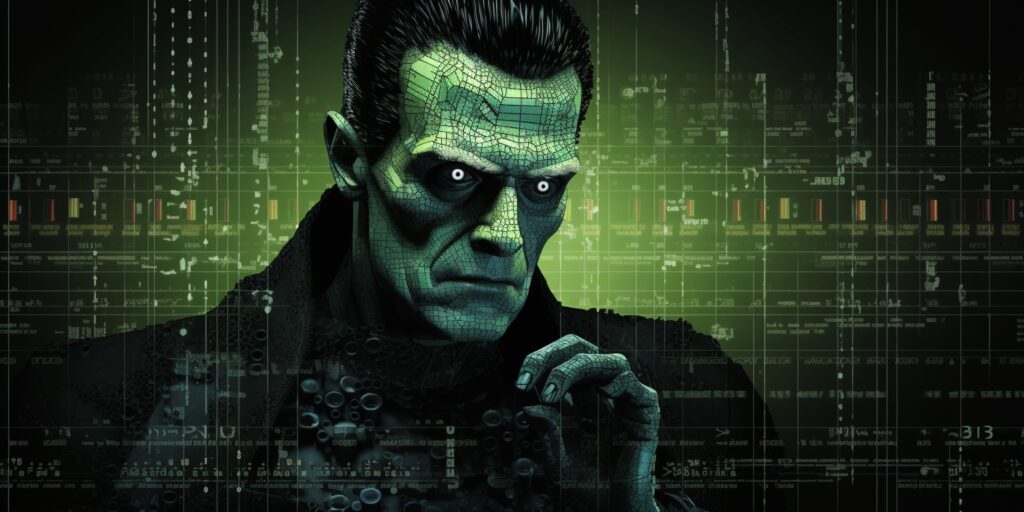Are you ready for Central Bank Digital Currencies? Like some kind of Frankenstein money, a CBDC combines the worst elements of the existing financial system with the dark power of algorithmic governance, all presented in a fake-blockchain wrapper.

Money is on the verge of a major upgrade, and though you may hope for more of the convenience of tapping your iPhone to buy a beer, what’s coming is a much more seismic change. Central bank digital currencies (CBDCs) are an unholy mash-up of two of the biggest technological disruptors – AI and blockchain – which may sound boring, but defenders of privacy already have their pitchforks out to fight what they view as Frankenstein money.
Mary Shelley’s Frankenstein tells the story of an experiment to create a super-human from remnant parts of corpses which goes horribly wrong, instead producing a monster that becomes more powerful than its master.
We should be bracing ourselves for a similar scenario with CBDCs, being tested by most of the world’s central banks right now. The results could be just as ugly and out of control as Frankenstein’s monster, given CBDCs combine the worst elements of existing money with the dark power of algorithmic governance, all presented in fake-blockchain wrapper.
CBDCs – Government-level fuckery
Explaining the potential impact of CBDCs is a challenge because the three key concepts behind them – algorithmic governance, blockchain and money – are a massive turn-off for Joe Public.
Putting that subject trio as interests in your Tinder profile might guarantee a swipe left but if you’re interested in understanding how government-level fuckery is going to be turned up to 11, those concepts are worth 10 minutes of your time.
What is money?
Like the majority of the adult population of planet earth, you probably spend a lot of time thinking about money, likely focused on how to acquire more of it. What 99% of people overlook is what money is and how it works.
Given that CDBCs are a new form of money, you need a primer on what we currently have to appreciate the dangers of building on its questionable existing logic while adding even more dangerous features.
If you didn’t take the link bait above, the TLDR about money is that it is one massive confidence trick. Money only has value because we all agree that it has.
Central banks create it at the push of a button, to quote Matthew McConaughey in the ‘Wolf of Street”, it’s fugazi, which works until it doesn’t (see Venezuela, Weimar Republic or Zimbabwe).
This lack of scarcity gives short-sighted governments, fixated only on winning the next election, an irresistible temptation to print their way out of trouble, running up humongous national debts, which brings the spectre of inflation or, worse still, its nastier cousin, hyperinflation.
To be fair, calling out fiat money, the term given to money backed by nothing but government power, as dangerous is a heterodox view held by fringe thinkers like Austrian economists, libertarians and Bitcoiners.
But boiled down, the logic is inescapable. If you increase the money supply, but production stays the same, prices go up….and up.
The US Congress currently goes through an annual bun-fight trying to decide how much more money it needs to magic out of thin are, what is euphemistically called increasing the ‘debt ceiling’.
The US government currently owes itself $31.6 trillion, increasing by about $ 1 million per second. If you’re lost for drama on Netflix, take a look at the US Debt clock website which shows in real time how the hole the US is digging itself is getting deeper.
The website wtfhappenedin1971 paints a broader picture of the impact inferred to what has become known as the Nixon Shock, the start of the modern fiat money era, with a huge range of economic indexes declining and diverging since the rails were removed from money creation.
Despite the red flags associated with the lack of scarcity of modern money, a supply cap isn’t one of the upgrade features of CBDCs.
Though there are a number of different potential CBDC implementations – what we’re concerned with here is the retail variant – all magpie elements of the ledger design of blockchain-based money, like Bitcoin, which emerged in 2009.
In practical terms, this would mean, for example, that there would be a fully digital version of the British Pound – which some have already nicknamed Britcoin. All Britcoin accounts, balances and transactions would be recorded in a massive government-controlled digital ledger.
Users would access their Britcoin accounts via mobile wallets, which means that on the surface, we wouldn’t necessarily notice much difference. In fact, there could be some significant benefits:
Increasing Tax Revenue
The ability to account for all CBDC money in circulation would revolutionise taxation – no more hiding money under the mattress or offshore; the black economy would disappear. More tax revenue could mean more spending on public services a reduction of spending deficits, which could lead to greater equality.
Tackling Organised Crime
Phasing out cash would strike a massive blow against organised crime because, contrary to popular belief, criminals favour cash, not crypto.
Simplifying the benefit system
CBDCs would mean citizens bank directly with the government, so distributing welfare would also become much simpler, faster and cheaper.
Of course, there is a huge BUT coming over the horizon. Bitcoin is a powerful force for democratising money because it is a transparent, borderless, permissionless and censorship-resistant ledger.
Unfortunately, CBDCs would inherit none of those features because they seek to centralise the state’s power over money further, not undermine it.
Britcoin would be permissioned, opaque and could be programmed not only to censor but surveil and control your use of money.
Whereas anyone can help maintain the Bitcoin network and view every transaction, CBDCs would only grant permission to trusted bodies to participate and access data. An extension of the Cantillon Effect.
Given each central bank will want supremacy for its digital sovereign currency, there will be open competition between CBDCs, so forget the idea of a seamless global currency.
The dangers of algorithmic governance
But arguably, the most Frankenstein-like aspect of CBDCs is the way they can cannibalise the programmable features of blockchain-based money in the pursuit of algorithmic governance of money.
- Money with an expiry date – Yes, that’s right; use it or lose it. Money with an expiry date would give central banks greater control over spending and macroeconomic goals. This isn’t a new idea. Demurrage, as a precursor to negative interest rates, was first suggested in 1906 by economist Silvio Gesell, trialled in Germany in the interwar period and mentioned by Kate Raworth in her 2017 book ‘Donought Economics‘ as part of her proposal for a more regenerative and equitable global economy.
- Restricting what you can buy – If you fear the nanny state, wait until your Britcoin wallet tells you that you’ve reached your weekly consumption quota of fast food, cigarettes or beer, or your consumption behaviour disqualifies you from free healthcare.
- Surveillance money – Not only could CBDCs restrict consumption, but AI would also enable the government to monitor every penny you spend and where you spend it, absorbing all this private information and sharing it with permissioned partners. Policing would be revolutionised, as would the insurance industry. Think Cambridge Analytica on steroids.
- Automatic deductions – Student loans, speeding tickets, and tax would be taken at source, along with any other debts you are deemed to owe. If you think this sounds like Black Mirror, the Chinese Communist Party (CCP) deducts party contributions from the salaries of their senior members, whereas paying fees is about party discipline.
This is really about party loyalty and discipline, not about the financial position of the party…What [President Xi Jinping (習近平)] is trying to do is to revive the party into an effective Leninist instrument, for which loyalty and discipline of party members are essential.
Members who do not pay their fees do not have a real commitment to the party and what it represents. Hence, it is important for the party to insist on its members paying the fees
Steve Tsang, a senior fellow at the China Policy Institute at the University of Nottingham
Why China is Leading the CBDC Race
It is no surprise that leading the pack to develop a live CBDC is one of the most authoritarian regimes on earth, China.
China has huge problems with capital outflows, and it is keener than most to know what its citizens do with their money.
How comfortable would a Chinese citizen be to use their digital yuan wallet to donate to Fallon Gong or a Uighur Charity? How much easier would it be for China to insist that any foreign companies trading with China do so via the digital yuan?
CBDCs & Walden Two Dystopia
A future where our use of money is not only controlled but surveilled might sound like something out of Black Mirror, but the idea is much older. BF Skinner, the famous American behavioural psychologist, wrote a controversial novel in 1948 called Walden Two.
The premise of Walden Two is that free will doesn’t exist; behaviour is determined by the environment, which the state can control to produce a utopia.
Skinner didn’t envision surveillance money, nor did Huxley or Orwell, but it certainly fits with the range of tools that could be used to remove free will and enable authoritarian control.
CBDCs – A fork in the road for money
As much as CBDCs do present an insidious threat, governments will find it hard to abolish all other forms of money, a prerequisite for their total control of the use of money to work.
All cash would have to be withdrawn from circulation, all existing cash reserves converted to digital equivalents, and what about the billions of pounds sloshing about offshore?
Governments may talk tough on tax evasion through offshore havens, yet there is no real appetite for cracking down in a meaningful way. Successive leaks from the Panama Papers and FinCen show how widespread the practice is, but you don’t really have to look far to find it.
Many people would argue that politicians aren’t the real decision makers and that the design and function of CBDCs would be influenced by conversations at Davos or by institutions like the Bank of Internation Settlements, which recently gloated that Bitcoin had been defeated.
It is that transparency part governments worldwide have latched onto, just like Doctor Frankenstein grabbing a particularly well-preserved brain and dispensing with the rest of the body.
Pandora’s box has already been opened, with the PBOC, under Xi Jinping’s third term, pushing ahead with a digital yuan as part of sweeping algorithmic governance that the Covid pandemic accelerated.
The question now is whether governments can maintain the illusion that money can and should only be controlled centrally. Can they continue to sell the virtues of CBDCs to the masses and resist the challenge of new forms of money, like Bitcoin, where privacy and control are prioritised?
As AI becomes more powerful, the programmable feature of CBDCs designed to maintain financial stability could turn into a bug with uncontrollable feedback loops. If CBDCs are Frankenstein money, their fate may well mirror that of their namesake in Shelley’s classic fable.
Struggling with his existence, he killed his master but, failing to find peace, vowed to kill himself, hoping no one would know of his existence, eventually drifting away on an ice raft, never to be seen again.
No Free Lunch
There is no such thing as a free lunch, but if you’re hungry to find out why, we’re here to help.
You can learn the meaning and origin of the no free lunch concept, as well as the broader philosophy behind the idea that nothing can ever be regarded as free.
We look at our relationship with money and truth, examining all of the supposed shortcuts, life hacks and get-rich-quick schemes.
